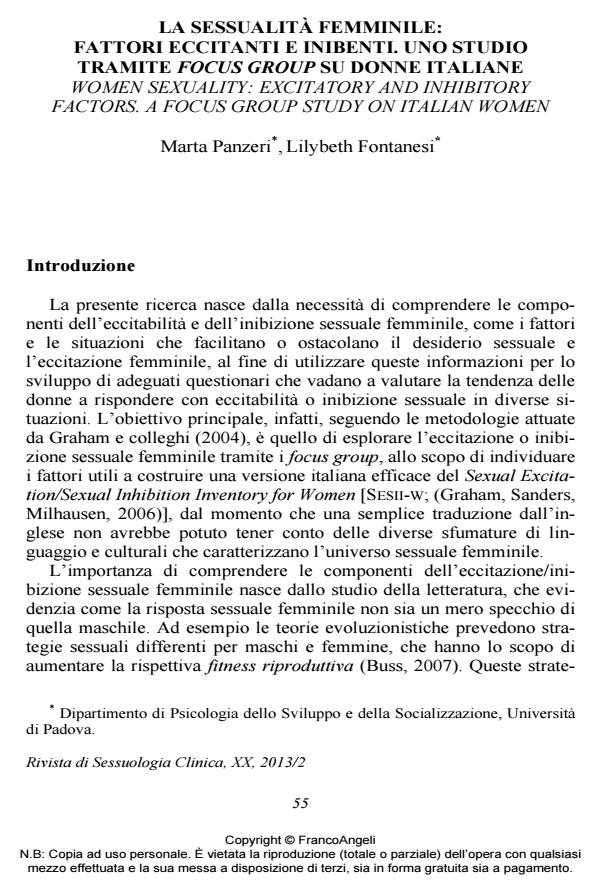Women sexuality: excitatory and inhibitory factors. A focus group study on italian women
Journal title RIVISTA DI SESSUOLOGIA CLINICA
Author/s Marta Panzeri, Lilybeth Fontanesi
Publishing Year 2013 Issue 2013/2 Language Italian
Pages 18 P. 55-72 File size 364 KB
DOI 10.3280/RSC2013-002003
DOI is like a bar code for intellectual property: to have more infomation
click here
Below, you can see the article first page
If you want to buy this article in PDF format, you can do it, following the instructions to buy download credits

FrancoAngeli is member of Publishers International Linking Association, Inc (PILA), a not-for-profit association which run the CrossRef service enabling links to and from online scholarly content.
The present research aims to outline the components of woman’s sexual desire, especially the psychological, emotional, situational and adaptive factors influencing the sexual response in women. Fifteen focus groups involving 114 women (M age = 30 years; range 18-76 years), were conducted. Participants described sexual arousal through physical (as vaginal lubrication), emotional, psychological, and behavioural factors. The relationship between sexual desire and arousal is complex: according to some women the sexual desire precedes the arousal, while for others sexual desire and arousal are simultaneous. According to the findings, there are a large selection of factors that enhance and inhibit sexual arousal, some of them are connected to the self (as feelings about one’s body or feelings of shame), or related to the partner (like the lack of complicity or his appearance), and associated to the situation. These results improve the understanding of desire; furthermore they may be used in order to develop of questionnaires to assess women sexuality.
Keywords: Women sexuality, arousal, inhibition, desire, focus groups, adaptive factors.
- Albanesi C. (2004). I Focus group. Roma: Carocci.
- Bancroft J., Janssen E. (2000). The dual control model of a male sexual response: a theoretical approach to centrally mediated Erectile dysfunction. Neuroscience and Biobehavioral Review, 24: 571-9. DOI: 10.1016/S0149-7634(00)00024-5
- Basson R. (2000). The female sexual response: a different model. Journal of Sex & Marital Therapy, 26: 51-65. DOI: 10.1080/009262300278641
- Buss D. M. (2004). Evolutionary psychology. New York: Allyn & Bacon.
- Buss, D. M. (2007). The evolution of human mating. Acta Psychologica Sinica, 39: 502-12. DOI: 10.1037/0022-3514.54.4.616
- Buss D.M. (2012). Evolutionary psychology: the new science of the mind, IV Edition. Pearson Education (trad. it: Psicologia evoluzionistica. Milano: Pearson Italia).
- Buss D.M., Schmitt D.P. (1993). Sexual strategies theory: an evolutionary perspective on human mating. Psychological Review, 100: 204-32. DOI: 10.1037/0033-295X.100.2.204
- Ellis B.J., Symons D. (1990). Sex differences in sexual fantasy: an evolutionary psychological approach. Journal of Sex Research, 27: 527-55. DOI: 10.1080/00224499009551579
- Gangestad S.W. (1993). Sexual selection and physical attractiveness. Human Nature, 4: 205-35. DOI: 10.1007/BF02692200
- Graham C.A., Sanders S.A., Milhausen R.R. (2006). The sexual excitation/sexual inhibition inventory for women: psychometric properties. Archives of Sexual Behavior, 35, 4: 397-09. DOI: 10.1007/s10508-006-9041-7
- Graham C.A., Sanders S.A., Milhausen R.R., Mcbride M.A. (2004). Turning on and turning off: A focus group study of the factors that affect women’s sexual arousal. Archives of Sexual Behavior, 33: 527-38. DOI: 10.1023/B:ASEB.0000044737.62561.fd
- Knoth R., Boyd K., Singer B. (1988). Empirical tests of sexual selection theory: predictions of sex differences in onset, intensity, and time course of sexual arousal. The Journal of Sex Research, 24:73-89. DOI: 10.1080/00224498809551399
- Miller G.F. (1998). How mate choice shaped human nature: a review of sexual selection and human evolution. In: Crawford C. e Krebs D., eds., Handbook of evolutionary psychology: ideas, issues, and applications. Mahwah, NJ: Lawrence Erlbaum.
- Morgan D.L. (1997). Focus groups as qualitative research. Thousand Oaks, CA: Sage.
- Simpson J.A., Gangestad S.W. (1992). Sociosexuality and romantic partner choice. Journal of Personality, 60: 31-52. DOI: 10.1111/j.1467-6494.1992.tb00264.x
- Sprecher S., Regan P.C. (1996). College virgins: how men and women perceive their sexual status. The Journal of Sex Research, 33: 3-15. DOI: 10.1080/00224499609551810
- Taylor J.F., Rosen R.C., Leiblum S.R. (1994). Self-report assessment of female sexual functioning: psychometric evaluation of the brief index of sexual functioning for women. Archives of Sexual Behavior, 23: 627-643. DOI: 10.1007/BF01541816
- Validation of the Sexual Inhibition/Sexual Excitation Scales (SIS/SES) in Italy: Assessing Gender and Age Differences of Sexual Functioning Marta Panzeri, Harold Dadomo, Lucia Ronconi, Lilybeth Fontanesi, in Archives of Sexual Behavior /2021 pp.2755
DOI: 10.1007/s10508-021-01972-3
Marta Panzeri, Lilybeth Fontanesi, La sessualità femminile: fattori eccitanti e inibenti. Uno studio tramite focus group su donne italiane in "RIVISTA DI SESSUOLOGIA CLINICA" 2/2013, pp 55-72, DOI: 10.3280/RSC2013-002003